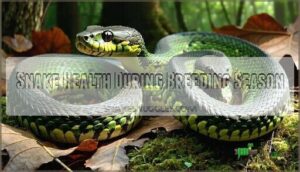This site is supported by our readers. We may earn a commission, at no cost to you, if you purchase through links.

Watch for behavior changes like increased activity or appetite loss; these are normal signs of the season. Feed them a nutritious diet with occasional supplements to support their energy needs.
Make sure they’ve got enough space to feel comfortable, and don’t forget fresh water—it’s the little things that count. Keep an eye out for health issues like stress or infections, and adjust conditions as needed.
Breeding season can be tricky, but with the right care, your snake will thrive.
Table Of Contents
- Key Takeaways
- Snake Breeding Season Basics
- What to Expect During Snake Breeding Season
- Snake Health During Breeding Season
- Nutrition and Diet During Breeding Season
- Environmental Considerations for Breeding Snakes
- Managing Snake Mating and Copulation
- Caring for Pregnant or Gravid Snakes
- Gestation and Incubation Periods in Snakes
- Post-Breeding Care and Snake Recovery
- Frequently Asked Questions (FAQs)
- What is common during snakes’ breeding season?
- How long is breeding season for snakes?
- Do snakes not eat during breeding season?
- How can I prevent a snake from breeding?
- How do you handle a snake during mating season?
- Is snake breeding a good idea?
- What does it take to breed a snake?
- When do snakes breed?
- How long does a snake’s mating season last?
- How to prepare snakes for breeding?
- Conclusion
Key Takeaways
- Keep your snake’s enclosure warm (80-85°F range) with proper humidity (60-70%) to mimic ideal breeding conditions.
- Watch for behavior changes like increased activity, skipped meals, or aggression, which are normal during breeding season.
- Provide a high-nutrient diet with occasional calcium and vitamin supplements to support their energy and reproductive health.
- Monitor their health closely to prevent stress-related issues, dehydration, or infections, and adjust care as needed.
Snake Breeding Season Basics
You’ll need to understand snake breeding season timing to provide proper care during this critical period.
Spring temperatures trigger most snakes’ mating instincts, though your specific species and geographic location will determine the exact schedule—think of it as nature’s own calendar that doesn’t always match yours.
What is Snake Breeding Season?
Picture your snake transforming from a sleepy winter resident into an active, hormone-driven creature—that’s snake breeding season in action. This natural reproductive cycle occurs when environmental conditions align perfectly for snake mating and reproduction.
Snake breeding season represents the period when snakes become sexually mature and ready to reproduce. During this time, you’ll witness dramatic shifts in breeding behavior as your reptile responds to powerful biological urges.
The season typically spans several weeks to months, depending on your snake’s species and location. Seasonal triggers that kickstart snake reproduction include:
- Rising temperatures after winter dormancy (usually 75-85°F)
- Increased daylight hours stimulating hormonal changes
- Environmental cues like humidity shifts and food availability
Geographic variation plays a huge role—snakes in Florida start earlier than those in Minnesota. Species differences also matter substantially. Some pythons breed year-round in captivity, while rattlesnakes follow strict seasonal patterns.
Understanding your snake’s specific reproductive cycles helps you prepare for potential snake aggression and behavioral changes during this fascinating period.
Duration of Snake Breeding Season
Snake breeding season duration isn’t one-size-fits-all.
Your snake’s seasonal variations depend heavily on species differences and geographic influence.
Most breeding seasons last anywhere from two weeks to four months, with climate impact playing a major role.
Warmer regions often see extended mating periods, while colder areas compress snake reproduction into shorter windows.
Food availability also affects timing – well-fed snakes may breed longer than those struggling to find prey.
Think of it like nature’s own scheduling system, perfectly timed for ideal offspring survival.
Factors Influencing Breeding Season
Now that you know how long snake breeding season lasts, let’s explore what actually triggers it.
Temperature variations kick-start the whole process – think of it as nature’s alarm clock.
Food availability matters tremendously; hungry snakes don’t make babies.
Your geographic location determines timing, while species differences create unique patterns.
Don’t forget brumation patterns – that winter slowdown sets the stage.
These factors work together like a perfectly timed orchestra for successful snake mating.
What to Expect During Snake Breeding Season
During breeding season, you’ll notice your snake acting like a completely different animal—they might refuse food, become more active, and display unusual behaviors that can catch even experienced keepers off guard.
Breeding season transforms your snake into an energetic, unpredictable creature, leaving even seasoned keepers surprised by their dramatic behavior shifts.
Understanding these changes in behavior, physiology, and the telltale signs of mating readiness will help you provide the best care and know what’s normal versus concerning.
Changes in Snake Behavior
When breeding season kicks off, your snake’s personality does a complete 180. These behavioral shifts signal nature’s ancient dance beginning.
Here’s what you’ll observe during snake breeding season:
- Activity Increase: Your typically calm snake becomes restless, exploring every corner of its enclosure with newfound energy.
- Appetite Changes: Don’t panic when meals get skipped—breeding behavior often trumps food.
- Aggression Levels: Males perform combat dances, competing fiercely for mating opportunities.
Changes in Snake Physiology
Your snake’s body undergoes remarkable hormonal shifts during breeding season, triggering a cascade of physiological changes.
Metabolic activity increases dramatically, causing noticeable weight fluctuations as energy demands spike. Digestive changes alter how nutrients are processed, making high-quality food essential.
Pheromone production ramps up for mate attraction, while mating organ development prepares their reproductive system. These metabolic changes affect appetite and behavior patterns, so don’t panic if your snake seems different—it’s nature’s way of preparing for reproduction.
Signs of Mating Season
During snake breeding season, you’ll typically notice increased activity levels and significant appetite changes in your reptiles.
Male combat becomes common as they compete through impressive wrestling matches. Females signal readiness through pheromone release, creating an invisible attraction network.
Shedding patterns often shift before mating behavior begins. These courtship signals help you recognize when your snakes are ready to breed.
Snake Health During Breeding Season
You’ll notice your snake’s health needs change substantially during breeding season, much like how athletes require extra care during training season.
Breeding snakes face increased stress, appetite changes, and higher risks of infections, so you’ll need to monitor them more closely and adjust their care routine accordingly to address these health needs.
Common Health Issues During Breeding
During mating season, your slithery friends face several health challenges that can turn breeding dreams into nightmares. Breeding stress tops the list, causing appetite loss and weakened immune systems.
You’ll also encounter parasite control issues, as stressed snakes become more susceptible to mites and internal worms. Infection prevention becomes essential when dealing with respiratory problems and mouth rot.
Watch for these common health issues:
- Nutritional deficiencies from refusing food during courtship rituals
- Egg-binding in females, requiring immediate attention
- Dehydration from improper humidity levels
Regular veterinary checkups help catch problems early. Remember, snake health during breeding complications requires vigilance – your reptiles depend on you spotting trouble before it becomes serious disease prevention territory.
Managing Stress and Disease
Stress can quickly derail snake breeding efforts, weakening immunity and inviting trouble like parasites or infections.
Use stress reduction strategies: keep their enclosure quiet and secure. Quarantine protocols are essential—don’t let new snakes bring uninvited germs.
Regular vet checkups catch issues early, boosting disease prevention. Prioritize their well-being with a reptile stress solution.
Remember, a calm snake is a healthy snake—no one thrives in chaos, not even reptiles, and this is key to successful snake breeding efforts.
Role of Nutrition in Snake Health
Keeping your snake in top shape during breeding season starts with a strong diet.
Nutrition impacts everything from energy to fertility.
Here’s how to boost snake health:
- Prey Variety: Rotate prey types to prevent nutrient deficiency.
- Hydration Importance: Always provide fresh water to support metabolism.
- Supplement Timing: Add calcium or vitamins sparingly to enhance breeding readiness.
- Obesity Risks: Avoid overfeeding; extra weight can harm reproduction.
Think of it as fine-tuning their fuel for success!
Nutrition and Diet During Breeding Season
Feeding your snake properly during breeding season isn’t just important—it’s essential.
A balanced diet, along with the right supplements, keeps them healthy and ready for the challenges of mating and reproduction.
Dietary Requirements for Breeding Snakes
Fueling your snake’s breeding nutrition is like prepping an athlete for a marathon.
Focus on:
- Prey variety to meet their diverse nutritional needs.
- Proper food size for smooth digestion and energy balance.
- Feeding frequency adapted to their activity levels.
A well-rounded snake diet during prebreeding care guarantees they stay healthy, hydrated, and ready for the season’s demands.
Supplements for Breeding Snakes
Boosting snake health during breeding season means focusing on calcium supplementation, vitamin importance, and fatty acids.
Calcium strengthens eggshells and bones—try trusted powders like Miner-all.
Vitamins, especially D and A, enhance immunity and shedding. Fatty acids, found in fish oils, support skin and reproduction.
Sprinkle supplements lightly on meals or mix with feeder insects. Hydration support is key too—always provide fresh water.
To guarantee proper bone and egg development, consider a snake calcium supplement. Proper supplement timing confirms your snake’s supplement needs are met effectively, ensuring overall health and reproduction success.
Feeding Strategies for Optimal Health
In the context of snake breeding, feeding strategies can make a big difference in health and success.
Focus on these simple tips:
- Feeding Frequency: Adjust meals to match energy needs, especially during breeding season.
- Prey Size: Choose prey that’s properly sized to prevent stress or digestion issues.
- Dietary Variety: Mix up prey types to meet nutritional needs and keep meals interesting.
- Supplement Timing: Use calcium or vitamin supplements to fill any nutritional gaps.
Juveniles may need feeding every 5-7 days.
Don’t forget hydration—it’s just as important as food!
Environmental Considerations for Breeding Snakes
Creating the perfect environment for breeding snakes isn’t as tricky as it sounds, but it does require attention to detail.
From temperature and humidity to enclosure setup, getting it right can make all the difference for a successful season.
Temperature and Humidity Control
Temperature control and humidity levels are essential for a thriving snake environment during the breeding season.
Snakes enjoy options, so create a thermal gradient with these Ideal Ranges:
| Temperature (°F) | Humidity (%) | Snake Environment Note |
|---|---|---|
| 80-85 | 60-70 | General comfort zone |
| 90-95 | 70-80 | Basking and digestion area |
| 75-80 | 50-60 | Cooler resting spot |
Use thermostats for precise adjustments and monitor with a hygrometer.
Seasonal adjustments, like higher humidity during shedding, keep your snakes happy.
Lighting and Visual Stimulation
Lighting plays a big role in snake breeding season, influencing both behavior and comfort.
Mimic natural light cycles (photoperiod effects) to trigger reproductive instincts. A 12-hour day-night rhythm works well for most species.
Use soft lighting to reduce stress and create a calming breeding environment. Incorporate UVB exposure and varied intensities for visual enrichment, encouraging natural behaviors.
- Photoperiod effects: Regulate light cycles to align with natural patterns.
- Visual enrichment: Use naturalistic setups with adjustable lighting.
- Stress management: Soft, steady light keeps snakes relaxed during breeding.
Good lighting keeps your snakes healthy and ready for successful mating!
Space and Enclosure Requirements
When setting up an enclosure for snake breeding, size matters—give them room to roam.
Use soft, easy-to-clean substrate and add hiding spots for privacy.
Include vertical space and enrichment items to keep them active.
Maintain a temperature gradient with warm and cool zones.
Good ventilation is essential for fresh air.
A proper habitat size is imperative for snake wellbeing.
A well-designed enclosure guarantees happy, healthy reptiles, and provides them with the necessary environment for breeding.
Managing Snake Mating and Copulation
You’ll need to watch for key behaviors like increased activity and pheromone release to spot when snakes are ready to mate.
Creating the right environment and introducing pairs carefully can make the process smoother—and maybe even less dramatic than a reality TV show, with a focus on complete concepts.
Recognizing Mating Behavior in Snakes
Spotting snake mating behavior is like solving a nature puzzle.
Snake mating behavior is nature’s riddle, revealed through restless movements, skipped meals, and pheromone-driven combat dances.
Look for these signs:
- Activity Increase: Your snake might slither around like it’s got places to be.
- Appetite Changes: Skipped meals? Their mind’s on courtship, not food.
- Combat Dances: Males may wrestle to impress.
- Pheromone Release: Females send invisible signals, inviting potential mates.
Stay observant—these clues lead to copulation!
Facilitating Successful Mating
Facilitating snake mating starts with understanding their natural courtship.
Use pheromone enhancement to spark interest, mimicking wild conditions. Watch for mating behavior like male combat or female receptivity cues, such as tail-lifting.
Make certain the enclosure provides space for rituals without overcrowding. Gradual introduction techniques help avoid stress, especially post-brumation.
Keep things calm—snakes don’t appreciate chaos during their romantic moments!
Copulation Process and Fertilization
During mating rituals, male snakes use their hemipenes—like nature’s double-pronged tools—for internal fertilization.
The copulation process involves the pair entwining, often lasting hours.
This guarantees fertilization success and promotes genetic diversity.
Some female snakes even store sperm for later use, aiding egg development.
It’s a delicate, fascinating dance, proving that even snakes have their own romantic choreography!
Caring for Pregnant or Gravid Snakes
Caring for a pregnant or gravid snake means focusing on her unique dietary and environmental needs.
You’ll also want to keep a close eye on her health and development to guarantee everything stays on track—because even snakes deserve a little prenatal TLC, with complete care for their well-being.
Identifying Pregnancy in Snakes
Wondering if your snake is pregnant? Look for these signs:
- Weight Gain and Belly Swelling: A fuller midsection is a strong clue.
- Behavior Changes: Appetite changes or nesting behavior, like clearing substrate, often emerge.
- Egg Visibility: Developing eggs may be seen through her skin.
- Palpation Techniques: Gently feeling for eggs can confirm pregnancy, though an ultrasound offers clearer identification.
Dietary and Environmental Needs
During the snake breeding season, meeting her nutritional needs and environmental needs is paramount.
Offer prey rich in nutrients and guarantee consistent hydration strategies with fresh water. Maintain proper temperature gradients and seasonal adjustments in humidity.
Add cozy spots for habitat enrichment—think of it as her spa retreat!
| Need | Why It Matters | How to Address |
|---|---|---|
| Nutrient Requirements | Supports egg development | Feed high-quality prey |
| Hydration Strategies | Prevents dehydration | Provide fresh water daily |
| Temperature Gradients | Ensures comfort and health | Adjust enclosure heating |
| Seasonal Adjustments | Mimics natural conditions | Control humidity levels |
| Habitat Enrichment | Reduces stress | Add hiding spots |
Monitoring Health and Development
Keeping your pregnant snake healthy means staying sharp with vital sign tracking and growth rate analysis.
Watch for behavioral pattern changes like restlessness or lethargy—these can hint at issues.
Regular reproductive organ assessments and genetic health screenings confirm everything’s on track.
Consistent egg development monitoring helps catch problems early.
Think of yourself as the snake’s health detective, spotting clues to keep her thriving.
Gestation and Incubation Periods in Snakes
You’ll need to keep a close eye on your snake’s gestation or incubation period, as timing varies widely by species.
Whether it’s eggs or live young, understanding these stages helps guarantee healthy development and successful hatching or birth.
Duration of Gestation and Incubation
Gestation and incubation times can feel like nature’s stopwatch, ticking differently for every snake species.
For example, ball pythons carry eggs for about 44 days, while anacondas might stretch that to seven months.
Species variation, temperature effects, and humidity impact all play a role in this timeline.
Think of egg incubation like tending a delicate greenhouse—consistent warmth (78-88°F) and humidity (50-70%) are your best friends.
Live birth species skip the egg stage but still need careful monitoring.
Keep a close eye on your snake breeding setup to guarantee smooth egg development and healthy, thriving offspring.
Factors Influencing Development
Development hinges on several key factors.
- Incubation Temperature: Keep it steady; extremes harm embryos.
- Humidity Levels: Too dry or damp disrupts egg moisture.
- Genetic Predisposition: Strong genes boost survival odds.
- Maternal Health: A well-fed mom guarantees robust eggs.
Balanced environmental conditions and proper care create the perfect hatchling environment, facilitating healthy egg incubation and growth.
Monitoring Egg Development
To keep your snake breeding efforts on track, monitoring egg development is a must.
Pay close attention to egg morphology, like size and clutch health, while ensuring temperature stability and proper humidity levels.
The ideal incubation temperature ranges from 27-30°C, depending on the stage.
Use candling techniques to check for veins and embryo growth—an egg candling lamp works wonders here.
Watch for signs of hatching problems as development progresses.
A little patience and consistent care go a long way in successful snake reproduction.
Post-Breeding Care and Snake Recovery
After breeding season, your snake needs extra care to recover and stay healthy.
A little patience and attention go a long way in helping them regain their strength and avoid complications.
Care for Female Snakes After Mating
After mating, female snakes deserve exceptional postbreeding care to facilitate smooth recovery.
Focus on:
- Nutrient Replenishment: Offer protein-packed meals to fuel egg development and gestation.
- Hydration Importance: Keep fresh water available to support shedding and overall health.
- Nesting Environment: Set up a cozy, private nest box for comfort and stress relief.
Think of it as her spa retreat!
Recovery Time for Breeding Snakes
After snake breeding season, recovery time is essential for their well-being.
Focus on nutrient replenishment to restore energy and maintain healthy activity levels. Offer a balanced diet and fresh water—hydration importance can’t be overstated.
Keep stress low by minimizing handling and providing a quiet, comfortable habitat. Regular veterinary checkups help spot any lingering issues.
Postbreeding recovery also means monitoring their behavior; if they seem sluggish or off, it’s time to reassess their care. Think of it as their well-deserved spa retreat!
Preventing Post-Breeding Complications
After snake breeding, focus on stress management to prevent common health issues like retained eggs or prolapse.
Keep an eye out for anorexia risks and infection signs during postbreeding recovery.
Proper nutrition supports healing, while hydration aids shedding issues.
Regular health monitoring is paramount—think of it as a wellness checkup.
A calm, stable environment guarantees smooth recovery and fewer complications.
Frequently Asked Questions (FAQs)
What is common during snakes’ breeding season?
Ever notice how snakes seem busier in spring?
During breeding season, they’re more active, eat less, and males even wrestle for mates.
Females release pheromones, while hormonal changes prep their bodies for reproduction.
How long is breeding season for snakes?
Breeding season for snakes typically lasts a few weeks to a few months, depending on the species.
Environmental factors like temperature, daylight, and food availability play a big role in determining the exact duration.
Do snakes not eat during breeding season?
Think of it like love on an empty stomach—many snakes skip meals during breeding season.
Their focus shifts to mating, not munching.
Appetite loss is normal, but make certain they’re healthy and hydrated during this time.
How can I prevent a snake from breeding?
To prevent snakes from breeding, separate males and females during mating season.
Control environmental factors like temperature and lighting that trigger breeding behavior.
Removing potential nesting areas also helps discourage reproduction. Think of it as matchmaking prevention, which involves considering the overall environment to prevent snake breeding, including the use of breeding behavior controls.
How do you handle a snake during mating season?
Funny how snakes get moody during mating season, right?
Handle them gently, avoid sudden movements, and don’t grab coiled ones.
Give them space, stay calm, and remember—they’re more focused on love than lunch!
Is snake breeding a good idea?
Breeding snakes can be rewarding but requires commitment.
You’ll need to manage their health, environment, and behavior carefully.
It’s not for everyone, but if you’re prepared, it can be a fascinating experience.
What does it take to breed a snake?
You’ll need patience, proper setup, and healthy snakes.
Create a controlled environment with ideal temperatures, humidity, and nutrition.
Monitor behavior for mating readiness, it’s like hosting a reptile romance—just without the candles and music, a situation that requires patience.
When do snakes breed?
Snakes typically breed in spring when temperatures rise and daylight increases.
Most species mate between March and May, but timing varies by location and species.
Warmer climates may see earlier breeding, while colder areas delay breeding it, especially due to the impact of temperatures.
How long does a snake’s mating season last?
A snake’s mating season usually lasts a few weeks to a couple of months, depending on the species.
Warmer climates might see longer seasons, while cooler regions keep it shorter.
Timing hinges on environmental factors.
How to prepare snakes for breeding?
Think of breeding prep as setting the stage for a show—control temperatures (78-88°F), provide high-nutrient meals, guarantee hydration, and monitor health.
A calm, clean, cozy habitat makes all the difference for success!
Conclusion
Caring for snakes during breeding season is like being a patient coach—you set the stage and let nature do its thing.
By focusing on proper snake breeding season care, you’ll guarantee your reptile stays healthy and stress-free.
Monitor their behavior, adjust the environment, and provide a balanced diet with supplements. Don’t forget the basics like fresh water and enough space.
With a little effort, you’ll help your snake thrive through this exciting yet demanding time.
- https://www.reptileforums.co.uk/threads/vitamin-supplements-for-snakes.215836/
- https://www.shop.repashy.com/blogs/news/vitamin-and-mineral-supplements-breaking-it-down
- https://www.thebiodude.com/blogs/reptile-and-amphibian-husbandry-basics/how-to-properly-utilize-supplements-for-your-reptiles-amphibians-and-arachnids?srsltid=AfmBOopLkdFU2owX2Wf9hNQScgYBEl05tpKMG-MpxI8BFCtc8E-enNQG
- https://www.davinciboas.com/shop_suppliments/
- https://www.aussiepythons.com/threads/supplements-for-snakes.179051/


















